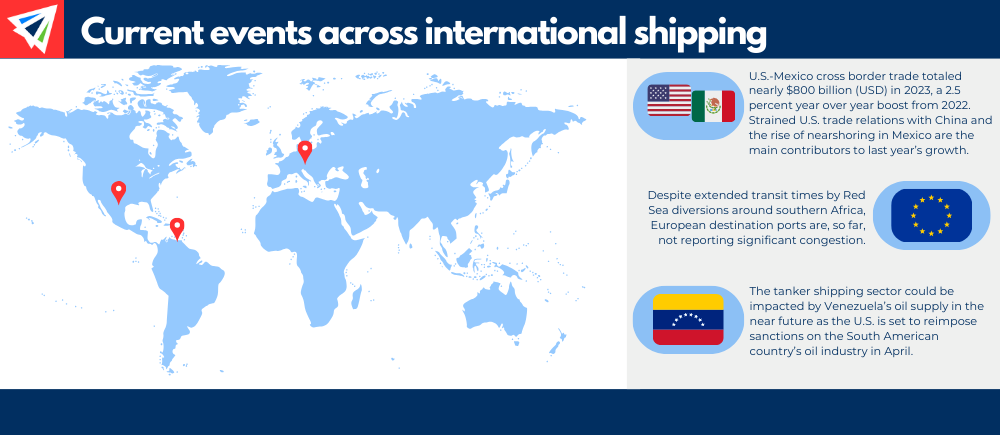Competitive Edge
February 14th, 2024
Stay Current with InterlogUSA
Latest Industry Happenings and Market Updates:

IMPORT: Asia to North America (TPEB)
Recent Developments:
- Lunar New Year (LNY) in China began Saturday and will conclude Feb. 24. Most Chinese businesses are closed, while port operations are limited.
- According to the Journal of Commerce, disruptions related to the Panama Canal’s outstanding drought have shown signs of improvement. Several carriers are resuming certain services through the challenged waterway.
Rates: Rates remain notably high following pre-LNY pressure and the ongoing impacts of uncertainty with the Red Sea. They should see a fair degree of softening after the holiday, however.
Space: Space is mostly open but has seen some tightening.
Capacity: Longer transit times around southern Africa are absorbing vessel capacity. However, carriers remain well-supplied with available vessels to manage the adjustment.
Equipment: There are no outstanding equipment deficits or bottlenecks.
TIPS:
- Hold your logistics partners accountable for frequent updates regarding current market conditions and routing impacts.
- Be flexible and adaptive to alternative service options, especially as it relates to potential savings on cost or transit.
IMPORT: Europe to North America (TAWB)
Rates: Rates have risen since the start of the month, but given the ongoing spell of dormant demand, this increase will likely be reeled in.
Space: Space is open.
Capacity: Capacity remains abundant. Carriers are partially curbing this by reducing the size of vessels operating on transatlantic lanes. Though, significant blank sailing programs have not been implemented.
Equipment: Availability on both origin and destination sides, unless advised otherwise.
TIPS:
- Book at least three weeks prior to the ready date.
- Communicate with your logistics partners to ensure that you’re up to speed on the EU ETS program and its evolving impacts on transatlantic trade.
- Keep an eye on carrier discretion when it comes to their managing of the market. While this trade favors shippers at the moment, carriers could become more aggressive with usual tactics, like rate increases or blank sailings, to prevent further lossmaking.
EXPORT: North America to Asia
Rates: Rates are level following an uptick in mid-January. They remain relatively low.
Capacity: Space remains open, particularly from West Coast ports, however carriers remain curbing capacity via blank sailings and slow steaming as U.S. import demand remains challenged.
Equipment: Barge services in China are temporarily suspended for the LNY holiday period.
TIPS:
- Insufficient communication with sailing schedules can lead to higher detention and demurrage fees as well as higher trucking and storage costs. Ensure your logistics partners are not keeping you and your cargo in the dark.
Freight News
U.S. Imports in January Up Almost 8 Percent From December
In the month of January, U.S. imports saw a 7.9 percent increase from the month prior, per data from Descartes. Total volume for January was 2,273,125 TEUS.
The Ports of Los Angeles and Long Beach received the biggest increases in container volumes; 77,085 and 48,054 TEUs respectively. While Port Houston and Port Charleston received the biggest decreases; -6.042 and -4,331 TEUs respectively.
Port transit delays in January did see increases throughout the top ports – besides the Port of LA, which actually showed a slight decrease, according to data. Not a shock, but the ports on the East Coast had increases in transit time delays.
Suez Canal Revenue Down in January 2024
Shouldn’t come as too much of a surprise but Suez Canal revenue during January 2024 was nearly half of what it was a year ago. Largely due to vessels having to reroute from the Red Sea and instead going around the Cape of Good Hope or other options, instead of going through the Suez Canal.
In January 2023 revenue was $804 million but in January this year… revenue was $428 million, per Marine Insight. The Suez Canal brought in $10.25 billion during 2023.
How the Asia-Europe lane is handling Red Sea Disruption —
Longer transit times are still occurring but, at the moment, the port terminals in Europe are “ handling the operations relatively seamlessly,” according to a Hapag-Lloyd spokesperson in an interview with the JOC.
Additionally, according to a spokesperson for Hutchison Ports, an operator of the UK’s largest container port of Felixstowe, their terminals were not seeing any congestion and no bottlenecks are expected in the coming weeks.
Whenever Suez Canal routings resume there’s a chance that some bottlenecks will occur, but if that happens it’s expected to be short-lived.
Watch January's Webinar!
TOPICS: The State of Global Trade
– Updates on the Red Sea/Suez Canal and the Panama Canal
– Rates/Capacity, routing options, and how all, or any, of this impacts you.
Sign Up For Our February Webinar!
Wednesday, February 21st at 10am CST we will be having our monthly Coffee & Cargo webinar.
(Please note: If you do not see your webinar invite after you register, please make sure to check your junk/spam folders. Reach out if you have any questions at [email protected])
If you have any topic suggestions or questions for our experts.. let us know!
Interlog  Insights
Insights
In last week’s insights, we discussed how the Panama Canal is staying at 24 daily transits – at least until April. Plus, a new trade agreement between the U.S. and Asian Pacific countries that’s focused on supply chain improvement.
If you’d like to view those insights, we’ll send you a copy. Email us at: [email protected]
This Friday at 10am CST our week three February insights will be going out to those who have subscribed. Click the button below to sign up.
Sign up for our
industry answers
Our team works to provide valuable, unique, and relevant content to assist you in finding solutions. Sign up now.

